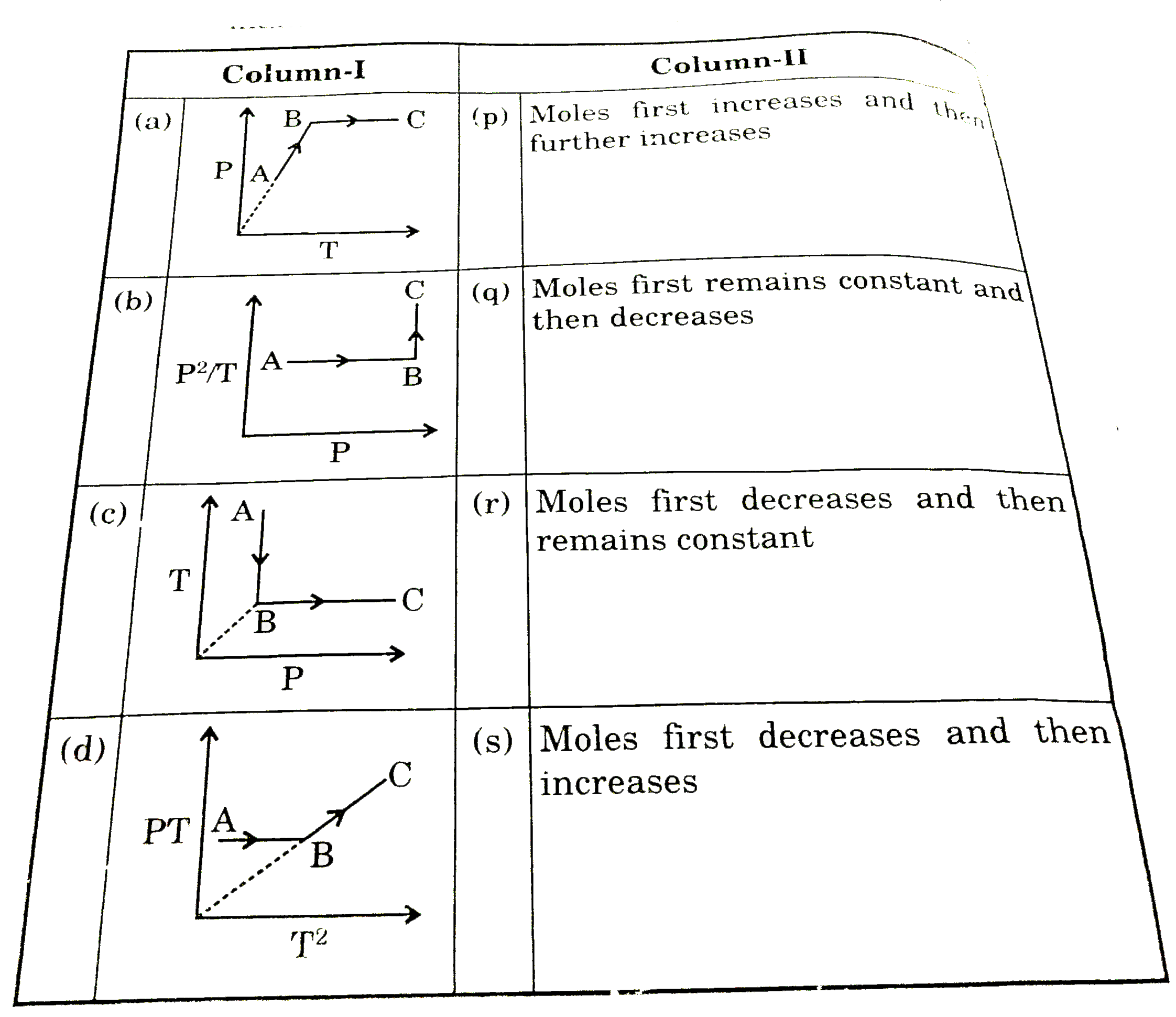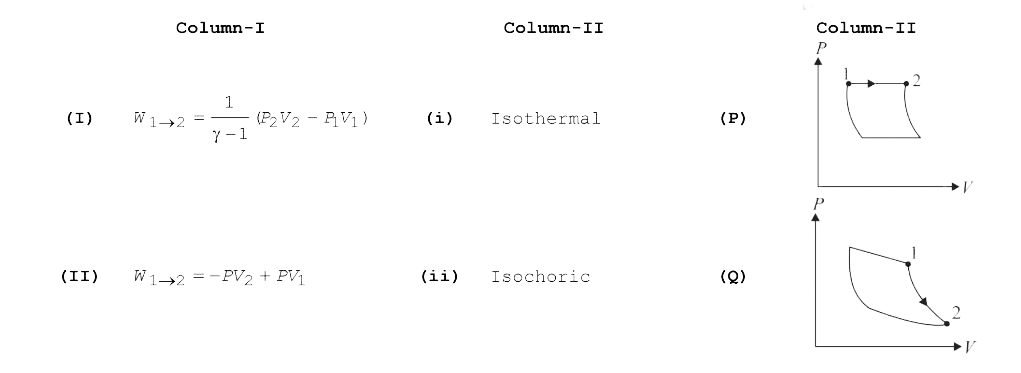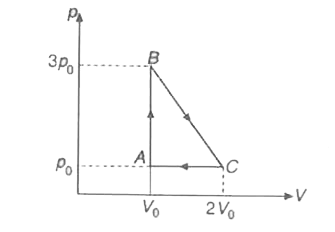In the graph shown below A-B, B-C , C-D are parts of the carnot cycle operating on an ideal gas.Consider only the path from State 1 to State 2 . W denotes the work in the path. Equations and plots in the table have standard notations γ is the ratio of heat capacities at constant pressure and constant volume. The moles of the gas is 'n'.

For which of the following options dQrev(sys)T>0 and simultaneously dQirrev(sys)T>0 If taken irreversibly
(I)(iv)(Q)
(IV)(i)(P)
(II)(iii)(R)
None of these
The correct Answer is:B
Only for the isothermal expansion would dQreversible and dQirreversible be positive
Hence the correct option is (IV)(i)(p)
Topper's Solved these Questions
Similar Questions
A red solid is insoluble in water.However it becomes soluble if some KI is added to water.Heating the red solid in a test tube results in liberation of some violet coloured fumes and droplets of a metal appear on the cooler parts of the test tube.The red solid is :
View SolutionSodium (Na=23) crystallizes in bcc arrangement with the interfacial separation between the atoms at the edge 53.6±. The density of sodium crystal is :
View SolutionOne mole of ideal monoatomic gas (γ=5/3) is mixed with one mole of diatomic gas (γ=7/5). What is γ for the misture? γ Denotes the ratio of specific heat at constant pressure, to that at constant volume
View SolutionFour moles of an ideal gas is initially in state A having pressure 2×105N/m2 and temperature 200K . Keeping the pressure constant the gas is taken to state B at temperature of 400K. The gas is then taken to a state C in such a way that its temperature increases and volume decreases. Also from B to C , the magnitude of dT/dV increases. The volume of gas at state C is eqaul to its volume at statem A. Now gas is taken to initial state A keeping volume constant. A total 1000J of heat is withdrawn from the sample of the cyclic process . Take R=8.3J/K/mol.
The work done in path B to C is
View SolutionTwo moles of an idea gas is initially in state A having pressure 1.01×105N/m2 and temperature 3O0k keeping pressure constant the gas is taken to state B temperature at B is 500K the gas is then taken to state C in such a way that its temperature increases and volume decreases also from B To c the magnitude of dTdV increases the volume of gas at C is equal to volume of gas at A now the gas is taken to initial state A keeping volume constant A total of 1200 J of heat is with drawn from the sample in the cyclic process the T-V graph for the cyclic process and work done in path B to C are respectively(takeR=8.3J/k/mol)
View SolutionThe following graphs are plotted for an ideal gas taken from state A to state B and then to state C, maintaining volume constant.

View SolutionFour moles of an ideal gas is initially in a state A having pressure 2×105N/m2 and temperature 200 K . Keeping pressure constant the gas is taken to state B at temperature of 400K. The gas is then taken to a state C in such a way that its temperature increases and volume decreases. Also from B to C, the magnitude of dTdV increases. The volume of gas at state C is eaual to its volume at state A. Now gas is taken is initial state A keeping volume constant. A total of 1000 J heat is rejected from the sample in the cyclic process. Take R=8.3J/K/mol.
The work done by the gas along path B to C is
View SolutionIn the graph shown below A-B, B-C , C-D are parts of the carnot cycle operating on an ideal gas.Consider only the path from State 1 to State 2 . W denotes the work in the path. Equations and plots in the table have standard notations γ is the ratio of heat capacities at constant pressure and constant volume. The moles of the gas is 'n'.

For which of the following options dQirrev(sys)T>dQrev(sys)T
View SolutionIn the graph shown below A-B, B-C , C-D are parts of the carnot cycle operating on an ideal gas.Consider only the path from State 1 to State 2 . W denotes the work in the path. Equations and plots in the table have standard notations γ is the ratio of heat capacities at constant pressure and constant volume. The moles of the gas is 'n'.

For which of the following options dQrevsysT=0 and dQrev(sys)T=0 it taken irreversibly
View SolutionOne mole of ideal monoatomic gas (γ=5/3) is mixed with one mole of diatomic gas (γ=7/5). What is γ for the mixture? γ Denotes the ratio of specific heat at constant pressure, to that at constant volume
View SolutionAn ideal gas is undergoing a cyclic thermodynamic process in different ways as shown in the corresponding P-V diagrams in column 3 of the table. Consider only the path from state 1 to state 2. W denotes the corresponding work done on the system. The equations and plots in the table have standard notations as used in thermodynamic process. Here is the ratio of heat capacities at constant pressure and constant volume. The number of moles in the gas in n. Which of the following options is the only correct representation of a process in which Delta U = Delta Q - P Delta V ?
View SolutionAn ideal gas is undergoing a cyclic thermodynamic process in different ways as shown in the corresponding P-V diagrams in column 3 of the table. Consider only the path from state 1 to state 2. W denotes the corresponding work done on the system. The equations and plots in the table have standard notations as used in thermodynamic process. Here is the ratio of heat capacities at constant pressure and constant volume. The number of moles in the gas in n.


Which of the following options is the only correct representation of a process in which ΔU=ΔQ−PΔV?
View Solutionएकपरमाणुक आदर्श गैस के 1 मोल को चित्र में दिखाए गए चक्रीय प्रक्रम ABCA में ले जाया जाता है | गणना कीजिए

(a) गैस द्वारा किया गया कार्य |
(b) पथ CA में गैस द्वारा बहिष्कृत ऊष्मा तथा पथ AB में गैस द्वारा अवशोषित ऊष्मा |
(c ) पथ BC में गैस द्वारा अवशोषित नेट ऊष्मा |
(d) चक्र के दौरान गैस द्वारा अर्जित उच्चतम ताप |
View SolutionA cycle followed by an engine (made of one mole of an ideal gas in a cylinder with a piston) is shown in figure. Find heat exchanged by the engine, with the surroundings for each section of the cycle. CV=32R

(a) A to B : constant volume
(b) B to C: constant pressure
(c) C to D: adiabatic
(d) D to A: constant pressure
View SolutionThe figure shows two paths for the change of state of a gas from A to B. The ratio of molar heat capacities in path 1 and path 2 is
View Solution
